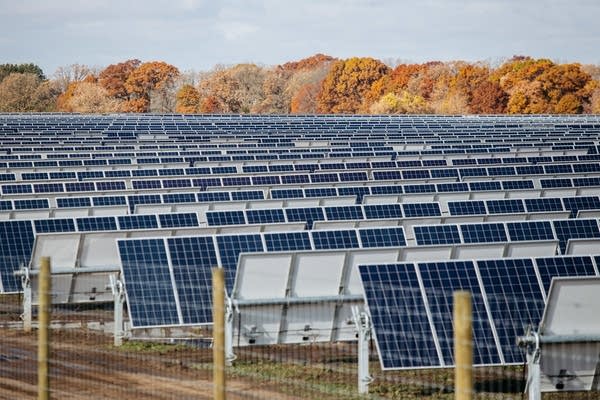Massive new solar plot marks big changes in rural Minnesota

Go Deeper.
Create an account or log in to save stories.
Like this?
Thanks for liking this story! We have added it to a list of your favorite stories.
A project like the North Star Solar plot is more likely to be found in the desert.
But on the rural landscape just north of the Twin Cities, a sea of solar panels now covers and area three times the size of Minneapolis' Lake Harriet.
North Star Solar began producing electricity on Wednesday. When it's fully online later this year, it will produce enough energy to power more than 20,000 homes.
The opening marks a big sign of change in outstate Minnesota.
Turn Up Your Support
MPR News helps you turn down the noise and build shared understanding. Turn up your support for this public resource and keep trusted journalism accessible to all.
"Maybe a year ago, one of the landowners said, 'Solar energy in Minnesota. What are they going to think of next?'" recalled Alok Sindher, a vice president with D.E. Shaw Renewable Investments.
North Star is the largest single solar energy facility in the Midwest. It was constructed in about six months after the developer spent more than a year negotiating with landowners and acquiring permits.

Xcel Energy will purchase solar power from North Star, and it'll be a big part of a major expansion in solar energy in the state, said Xcel Minnesota President Chris Clark. He likened the expansion to what happened several years ago with wind energy.
"We've had great success with wind. We've seen a tremendous maturing of the wind industry," Clark said, "and a project like this one really shows that solar is coming quickly and is going to be a great part of our system as well."
State regulators just approved Xcel's 15-year energy plan to reduce carbon emissions by 60 percent and generate a third of its electricity from renewable sources by 2030.

By then, Clark said, at least 8 percent of Xcel's electricity in the Upper Midwest will be generated from solar.
Finding sites for giant facilities like North Star isn't easy.
Although local government officials signed off on it, some neighbors were against it. Barb Holcomb, one of the landowners benefiting financially from the project, says some of her neighbors threatened to stop the project.
"They were very angry because of the traffic and the noise and they wanted to see the wildlife," she said. "They didn't want changes."
But her husband Clifford Holcomb says putting solar panels on land that used to be not very good corn and soybean fields makes a lot more sense.
"There's no money in farming," he said, "not around here, anyway."

While the solar installation is replacing corn and soybean fields, there's still room for native prairie plants under and around the panels that will serve as habitat for bees and other pollinators.
For the Holcombs and some of the other landowners, the North Star project is allowing them to move on from farming at a time in their lives when most other people their age are retired.
Dennis Anderson and his father Phil were the first landowners to sign up.
"He needed something to force him out of farming so that he could finally retire at age 97," Dennis Anderson said of his dad.
The elder Anderson isn't so sure. "I've still got land," he said, smiling.
That aside, Phil Anderson feels proud to know that much of his land will produce local property tax revenue and electricity decades after he's gone.
"I'm glad to live to see the thing completed," he said. "To get a source of energy like the sun for free, that's pretty hard to beat."


